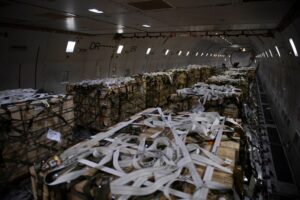A new study released Monday details concerns the U.S. defense industrial base is “not adequately prepared” for future conflict, with efforts to assist Ukraine highlighting areas of weakness in a potential fight with China.
The new report from the Center for Strategic and International Studies (CSIS) offers a bevy of recommendations to bolster confidence in the defense industrial base ranging from reassessing munitions and weapon replenishment requirements to establishing a strategic munitions reserve and streamlined Foreign Military Sales (FMS) processes.

“The U.S. defense industrial base is not adequately prepared for the competitive security environment that now exists. It is currently operating at a tempo better suited to a peacetime environment. In a major regional conflict—such as a war with China in the Taiwan Strait—the U.S. use of munitions would likely exceed the current stockpiles of the U.S. Department of Defense (DoD), leading to a problem of ‘empty bins,’” writes Seth G. Jones, director of CSIS’ International Security Program, in his report.
The study notes the U.S. has provided Ukraine with over $24 billion in weapons to assist in its fight against Russia’s ongoing invasion, and cites support for continuing such efforts, while adding the process has “exposed serious deficiencies” in the U.S. defense industrial base.
“The United States has been slow to replenish its arsenal, and the DoD has only placed on contract a fraction of the weapons it has sent to Ukraine. Many U.S. allies and partners in Europe also have defense industrial bases that are unprepared for major war, heavily reliant on the United States, and chronically underfunded,” the study states.
Concerns with the state of the defense industrial base along with the results from several CSIS war games highlight that the U.S. “would likely run out of some munitions—such as long-range, precision-guided munitions—in less than one week in a Taiwan Strait conflict” [with China], according to the report.
“These shortfalls would make it extremely difficult for the United States to sustain a protracted conflict—and, equally concerning, the deficiencies undermine deterrence. They also highlight that the U.S. defense industrial base lacks adequate surge capacity for a major war,” the study states.
The study includes a chart detailing the status of the U.S. inventory for critical munitions and weapons transferred in large numbers to Ukraine, with the following capabilities marked as “low” in their stockpile count: Javelin and Stinger missiles, 155mm howitzer and associated rounds and counter-artillery radars.
“The U.S. military services have underinvested in weapons systems and munitions for a conventional war, and the DoD’s acquisition system faces challenges in creating the incentives for industry to invest in sufficient stockpiles of key weapons systems,” CSIS writes in the report.
CSIS in its report calls for DoD to place a focus on assessing wartime demands for capabilities, to include reassessing total munitions and weapon replenishment requirements, which it says will assist in setting “a more certain production future for weapons manufacturing.”
“Instead of asking industry their capacity to produce specific munitions or weapons systems, a better question may be asking what the DoD needs, based on operational plans and wartime scenarios and analyses. Congress could be helpful in holding hearings, as well as requiring the DoD and independent entities to conduct a classified study to assess how many days it would take before the U.S. military exhausted its stockpiles of key munitions in one or more major wars,” CSIS offers in its report.
The study also recommends establishing a strategic munitions reserve, to include buying one or two lots of long-lead subcomponents for select critical munitions to reduce the up to two-years of lead time required to produce such weapons if conflicts were to occur.
CSIS also calls for creating a “sustainable munitions procurement plan” to meet weapons manufacturing demand, to include specific investments in systems “such as strike, air defense, and missile defense—to deter and fight major powers to maximize rates.”
Building on the fiscal year 2023 National Defense Authorization Act’s inclusion of a provision allowing the Pentagon to buy select critical munitions using multi-year contracts, the report calls for the U.S. to further “broaden acquisition approaches and take advantage of flexibility in the contracts process.”
“It is important to buy missiles and munitions smarter to take advantage of scale and market power, including using tools such as advanced procurement, multiyear procurement, and economic order quantity processes. These tools have been limited to large programs such as ships and aircraft, but they could help with missiles and munitions,” the report states.
CSIS also cites an importance in streamlining the FMS process, adding the “system badly needs to be reformed” to get allies and partners critical weapon systems more quickly, while also detailing how improving “co-production” efforts with other countries can help improve the state of the defense industrial base.
“Co-production facilities can have multiple benefits, including strengthening allies and partners, increasing economies of scale, and supporting the U.S. industrial base” CSIS writes in the report. “There have been several recent co-production examples worth exploring in more detail, including HIMARS with Poland, PrSM with Australia, Naval Strike Missile with Norway, and SM-6 components and Tomahawks for Japan and Australia.”